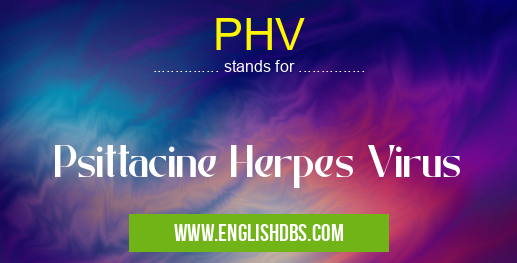What does PHV mean in UNCLASSIFIED
PHV, an abbreviation in the field of MISCELLANEOUS, stands for Psittacine Herpes Virus. This virus primarily affects birds, particularly members of the parrot family, including parrots, macaws, cockatoos, and lovebirds.

PHV meaning in Unclassified in Miscellaneous
PHV mostly used in an acronym Unclassified in Category Miscellaneous that means Psittacine Herpes Virus
Shorthand: PHV,
Full Form: Psittacine Herpes Virus
For more information of "Psittacine Herpes Virus", see the section below.
What is PHV?
PHV is a highly contagious virus that can cause a range of illnesses in birds, from mild respiratory symptoms to severe and potentially fatal infections. It is transmitted through direct contact with infected birds or their bodily fluids, such as saliva, feces, or dander.
Symptoms of PHV
PHV can manifest in birds in various ways, including:
- Respiratory distress, such as coughing, sneezing, and wheezing
- Ocular discharge, swelling, and conjunctivitis
- Skin lesions, particularly on the face, feet, and cloaca
- Nervous system abnormalities, such as tremors, seizures, and incoordination
- Gastrointestinal upset, including vomiting and diarrhea
Transmission and Prevention
PHV is highly contagious among birds and can spread rapidly in flocks. It is essential to maintain good hygiene practices, such as:
- Isolating infected birds
- Disinfecting cages and equipment
- Avoiding contact between healthy and infected birds
- Vaccinating birds against PHV
Essential Questions and Answers on Psittacine Herpes Virus in "MISCELLANEOUS»UNFILED"
What is Psittacine Herpes Virus (PHV)?
PHV is a contagious viral disease that primarily affects parrots and other psittacine birds. It can cause a range of symptoms, from mild respiratory issues to severe neurological damage and death.
How is PHV transmitted?
PHV is primarily transmitted through direct contact with infected birds or their bodily fluids, including saliva, feces, and dander. It can also be spread through contaminated objects, such as cages, toys, and food bowls.
What are the symptoms of PHV?
Symptoms of PHV vary depending on the strain of the virus and the bird's immune system. They can include respiratory issues (e.g., coughing, sneezing), eye infections, skin lesions, neurological problems (e.g., seizures, paralysis), and organ failure.
How is PHV diagnosed?
PHV can be diagnosed through a combination of physical examination, laboratory testing (e.g., PCR, DNA hybridization), and serological tests (e.g., ELISA).
Is there a cure for PHV?
There is currently no cure for PHV. Treatment aims to manage the symptoms and prevent secondary infections. Antiviral medications, supportive care (e.g., fluid therapy, oxygen), and isolation can help improve the bird's chances of survival.
How can I prevent the spread of PHV?
To prevent the spread of PHV, it is important to quarantine new birds, practice good hygiene (e.g., frequent hand washing), disinfect cages and equipment regularly, and avoid contact between infected and healthy birds.
What are the public health risks of PHV?
PHV can rarely infect humans, usually through direct contact with infected birds or their bodily fluids. In humans, it can cause a range of symptoms, including skin lesions, respiratory issues, and eye infections.
Final Words: PHV is a significant threat to birds, especially parrots. Understanding the virus, its symptoms, and transmission routes is crucial for bird owners and veterinarians to prevent outbreaks and protect the health of their feathered companions. Early detection and appropriate treatment are essential for managing PHV infections and minimizing their impact on birds.
PHV also stands for: |
|
| All stands for PHV |
